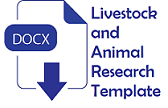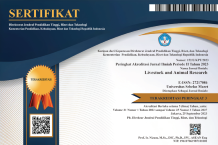Cases of cow reproductive disorders at The Northern Bandung Dairy Farmer Cooperative by using Geographic Information System (GIS) approach
Abstract
Objective: This study aimed to determine the percentage of reproductive disorders in dairy cows at The Northern Bandung Dairy Farmer Cooperative (KPSBU Lembang) based on body condition score (BCS) and season factor and determined the distribution map.
Methods: The object of this study was secondary data on dairy cows from 2019 to 2021 registered on the cooperative database. The parameters of this study were type, case percentage, risk factor, and distribution of reproductive disorders. The data were analyzed descriptively based on BCS and season factors.
Results: The percentage results were presented in tables and figures after being processed using Microsoft Excel, while the distribution maps were processed using the QGIS application. The percentages of reproductive disorders in KPSBU Lembang in 2019–2021 respectively as follows: Retained placenta were 11.5%, 14.9%, and 14.4%; Dystocia were 11.5%, 12.6%, and 14.2%. Ovarian function disorders (follicular cyst and corpus luteum cyst) were 10.2%, 8.8%, and 9.9%; Endometritis was 9.3%, 9.5%, and 10.4%. Based on the distribution maps of reproductive disorders, it was known that all villages in Lembang District in 2021 had cows with reproductive disorders.
Conclusions: The reproductive disorders in dairy cows at KPSBU Lembang had retained placenta, dystocia, ovarian function disorder (follicular cyst and corpus luteum cyst), and endometritis. Dystocia and retained placenta are the highest cases in KPSBU Lembang during the dry and rainy seasons. Areas that had dairy cows with unideal BCS became the highest area of each type of reproductive disorder cases.
Objective: This study aimed to determine the percentage of reproductive disorders in dairy cows at The Northern Bandung Dairy Farmer Cooperative (KPSBU Lembang) based on body condition score (BCS) and season factor and determined the distribution map.
Methods: The object of this study was secondary data on dairy cows from 2019 to 2021 registered on the cooperative database. The parameters of this study were type, case percentage, risk factor, and distribution of reproductive disorders. The data were analyzed descriptively based on BCS and season factors.
Results: The percentage results were presented in tables and figures after being processed using Microsoft Excel, while the distribution maps were processed using the QGIS application. The percentages of reproductive disorders in KPSBU Lembang in 2019–2021 respectively as follows: Retained placenta were 11.5%, 14.9%, and 14.4%; Dystocia were 11.5%, 12.6%, and 14.2%. Ovarian function disorders (follicular cyst and corpus luteum cyst) were 10.2%, 8.8%, and 9.9%; Endometritis was 9.3%, 9.5%, and 10.4%. Based on the distribution maps of reproductive disorders, it was known that all villages in Lembang District in 2021 had cows with reproductive disorders.
Conclusions: The reproductive disorders in dairy cows at KPSBU Lembang had retained placenta, dystocia, ovarian function disorder (follicular cyst and corpus luteum cyst), and endometritis. Dystocia and retained placenta are the highest cases in KPSBU Lembang during the dry and rainy seasons. Areas that had dairy cows with unideal BCS became the highest area of each type of reproductive disorder cases.
Keywords
Full Text:
PDFReferences
- Badan Pusat Statistik. 2022. Populasi sapi perah menurut provinsi (ekor), 2019-2021 [Internet]. Badan Pusat Statistik Website [cited 2022 Mei 18]. Available from: https://www.bps.go.id/indicator/24/470/1/populasi-sapi-perah-menurut-provinsi.html
- Deka, R. P., U. Magnusson, D. Grace, T. F. Randolph, R. Shome, and J. F. Lindahl. 2021. Estimates of the economic cost caused by five major reproductive problems in dairy animals in Assam and Bihar, India. Animals: an open access journal from MDPI. 11(11): 3116. Doi: 10.3390/ani11113116
- Rukayah, D. S. 2013. Potensi kerugian finansial akibat abnormalitas selang beranak pada usaha ternak sapi perah. Universitas Padjadjaran.
- Markoski, B. and S. Gorin. 2015. Geographic information systems in function of environmental protection. Contributions, Sec. Nat. Math. Biotech. Sci. MASA. 36: 135–143.
- Dinas Kependudukan dan Pencatatan Sipil Kabupaten Bandung Barat. Geographic Information System (GIS) Kab. Bandung Barat, Kecamatan Lembang, dan 16 desa. BIDANG P-I-A-K Ver.1.2; c2019 [cited 2023 Feb 15]. Available from: https://disdukcapil.bandungbaratkab.go.id/Home/gis/lembang
- Divers, T. J, and S. F. Peek. 2018. Rebhun's diseases of dairy cattle. 3rd ed. Elsevier Inc., Missouri, US.
- Beagley, J. C., K. J. Whitman, K. E. Baptiste, and J. Scherzer. 2010. Physiology and treatment of retained fetal membranes in cattle. J. Vet. Intern. Med. 24(2): 261–268. Doi: 10.1111/j.1939-1676.2010.0473.x
- Phillips, C. J. C. 2018. Principle of cattle production. 3rd Ed. CABI. CSIRO Publishing, Australia.
- Prihantini, T. T., S. Sobirin, dan T. Handayani. 2017. Hubungan keterpaparan kekeringan dengan peternakan sapi perah di lereng/kaki gunung merbabu. Prosiding Industrial Research Workshop and National Seminar. 8: 173-182.
- 10. Tao, S., G. E. Dahl., J. Laporta, J. K. Bernard, Orellana Rivas, R. M., and Marins, T. N. 2019. Physiology Symposium: Effects of heat stress during late gestation on the dam and its calf. J. Anim. Sci. 97(5): 2245–2257. Doi: 10.1093/jas/skz061
- 11. Simões, J., and G. Stilwell. 2021. Calving management and newborn calf care. Springer Nature, Switzerland.
- 12. Mekonnen, M. and M. Nibret. 2016. A Review on Dystocia in Cows. Eur. J. Biol. Sci. 8(3):91-100. Doi: 10.5829/idosi.ejbs. 2016.91.100
- 13. Ohtsuka, H., Y. Murase, T. Ando, M. Kohiruimaki, M. Mukai, M. Oikawa, K. Petrovski, and Morris. 2009. Effect of body condition score of the dairy cow on the in vitro immune response of peripheral blood mononuclear cells to progesterone stimulation. J. Vet. Med. Sci. 71(5): 549–553. Doi: 10.1292/jvms.71.549
- 14. Judi, T., I. A. T. Ligaya., dan Rista P. 2022. Hubungan retensio sekundinae dan endometritis dengan efisiensi reproduksi pada sapi perah: studi kasus di koperasi peternak sapi Bandung Utara (KPSBU) Lembang. IPB University Scientific Repository.
- 15. Jeong, J. K., H. G. Kang, and I. H. Kim., 2018. Relationships between calving season and the incidence of postpartum disorders, milk yield, and reproductive performance in dairy cows. J Vet Clin. 35(6): 251-257. Doi: 10.17555/jvc.2018.12.35.6.251
- 16. Lee, S.C., J. K. Jeong, I. S. Choi, H. G. Kang, Y. H. Jung, S. B. Park, and I.H. Kim. 2018. Cytological endometritis in dairy cows: diagnostic threshold, risk factors, and impact on reproductive performance. J. Vet. Sci. 19(2): 301-308. Doi: 10.4142/jvs.2018.19.2.301
- 17. Tagesu, A. 2018. Review on the reproductive health problem of dairy cattle. Dairy and Vet Sci J. 5(1): 1-12. Doi: 10.19080/JDVS.2018.05.555655
- 18. Matsuyama, S., and K. Kimura. 2014. Regulation of gonadotropin secretion by monitoring energy availability. Reproductive Medicine and Biology, 14(2): 39–47. Doi:10.1007/s12522-014-0194-0
- 19. Webster, J. 2020. Understanding the dairy cow. Sci J. 5(1). Doi: 10.19080/JDVS.2018. 05.555655
- 20. Hermadi, H., M. Hariadi, and Susilowati. 2018. The ovarian hypofunction: A Case in Cow Management Therapy. Advances in Health Sciences Research. 5:311-316. Doi: 10.2991/icoh-17.2018.63
- Long, S. T., P. V. Gioi, and N. T. Suong. 2021. Some factors associated with ovarian disorders of dairy cattle in Northern Vietnam. Tropical Animal Science Journal. 44(2):240-247. Doi: 10.5398/tasj.2021.44.2.240










